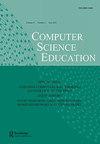Nevertheless, They Persisted: Factors that Promote Persistence for Women and Racially/Ethnically Minoritized Students in Undergraduate Computing
IF 2.2
Q1 EDUCATION & EDUCATIONAL RESEARCH
引用次数: 6
Abstract
ABSTRACT Background and Context As computing fields aim to both expand and diversify, narrowing representation gaps in undergraduate computing majors requires focus on retaining women and racially/ethnically minoritized students to the point of degree attainment. Objective This study addresses the factors that contribute to persistence in computing majors among undergraduate students who took introductory computing courses during the first two years of college. Method Student survey data from 15 research universities in the United States were used to explore differences in persistence patterns by students’ gender and racial/ethnic identities. Further, we used logistic regression to examine factors that promote persistence in computing majors, with attention to conditional effects by gender and race/ethnicity. Findings Results show that women are less likely than men to persist in computing majors two years following completion of the introductory CS course. Findings suggest that proximal socialization experiences, specifically those related to students’ self-confidence, sense of fit, and in-class experiences, are important to student persistence in computing fields. Implications: The results suggest that peer experiences in computing are central to student persistence in the major. Hence, computing departments can act on these findings by strengthening the community within their majors and fostering positive peer interactions among students.然而,他们坚持:促进女性和种族/少数民族学生在本科计算机专业坚持的因素
背景和背景随着计算机领域的扩张和多样化,缩小本科计算机专业的代表性差距需要关注留住女性和少数种族/民族学生以获得学位。目的本研究旨在探讨大学前两年选修计算机入门课程的大学生对计算机专业坚持学习的影响因素。方法利用美国15所研究型大学的学生调查数据,探讨学生性别和种族/民族认同对持久性模式的影响。此外,我们使用逻辑回归来检验促进计算机专业持久性的因素,并注意性别和种族/民族的条件效应。研究结果显示,在完成计算机科学入门课程两年后,女性比男性更不可能坚持学习计算机专业。研究结果表明,近端社会化体验,特别是与学生自信、适应感和课堂体验相关的体验,对学生在计算机领域的持久性很重要。启示:结果表明,计算机方面的同伴经验是学生坚持专业的核心。因此,计算机系可以根据这些发现采取行动,加强专业内的社区,促进学生之间积极的同伴互动。
本文章由计算机程序翻译,如有差异,请以英文原文为准。
求助全文
约1分钟内获得全文
求助全文
来源期刊

Computer Science Education
EDUCATION & EDUCATIONAL RESEARCH-
CiteScore
6.90
自引率
3.70%
发文量
23
期刊介绍:
Computer Science Education publishes high-quality papers with a specific focus on teaching and learning within the computing discipline. The journal seeks novel contributions that are accessible and of interest to researchers and practitioners alike. We invite work with learners of all ages and across both classroom and out-of-classroom learning contexts.
 求助内容:
求助内容: 应助结果提醒方式:
应助结果提醒方式:


